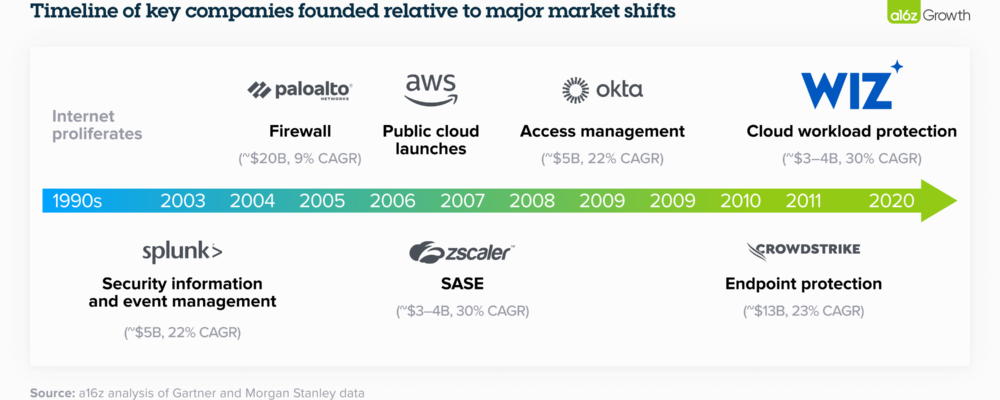Technology companies have rediscovered their roots as innovators in national security and as critical partners to the Department of Defense. In this session from the a16z American Dynamism Summit, moderated by CNBC anchor Morgan Brennan, Anduril Cofounder and CEO Brian Schimpf lays out the case for how and why technology plays a critical role in helping ensure a safer world.
Here is a transcript of their conversation:
Morgan Brennan: It’s great to be on stage with you. It’s great to be here with everybody in the audience as well. There’s a lot to get to, but the first place I want to start is, we just had the Deputy Defense Secretary present on stage. She was talking about innovation, the intersection of Silicon Valley and DOD, government work. As somebody who’s on the other side of that equation, and what I will call, use the word, disruptor, in terms of breaking into defense and doing more work with the Pentagon, your thoughts?
Brian Schimpf: Well, I think, you know, I’ve been working in the defense space for maybe 15, 17 years now. And when I first started out, it was just impossible to break in, right? It was impossible to imagine new companies could do anything of substance. It was just sort of scratching at the surface. Fast forward now, you know, to even when we started Anduril, it was still hard to imagine that you could have new entrants doing anything large and at scale, new companies working on weapons. Larger aircraft just didn’t seem plausible, especially ones that focus on software. Today we’re at a place where, you know, we’re fortunate to be able to disclose we’re working with the Air Force on the Loyal Wingman project, which is an incredibly big change from where we were when we even started with this.
And I think the reality of how this is, you know, you’re going to see change in the department, how you’re going to see change of making this an area where the best technology, the best technologists want to work is actually allowing new entrants to do things at scale. Like, that is the bottom line, right?
And we’re starting to see areas where that is true. I think Replicator is another great example where the focus of this, on actually deploying at scale, becomes very, very key and not just having these kind of surfaced small-scale things. So that shift is wildly different than what it was when we started, and we’re incredibly excited that this is now feeling very possible. Whereas when we started, it was not obvious that this was going to work.
Morgan: There’s a lot there for me to unpack with you. And the first place I’m going to start is the fact that it has started to become easier. I mean, there are more and more…we see it in the amount of investment dollars that are going into defense tech right now.
There are more and more companies and startups that are aspiring to work with the DOD. But you still hear the term over and over again, Valley of Death. Anduril is still an exception. Maybe it’s one of the leaders, but it’s few and far between in terms of companies being able to work with DOD and in a meaningful way.
Brian: Yeah, I mean, look, I think the hard reality with this is it’s just like venture, it’s just like any sort of industry where there aren’t going to be 500 success stories. That is unlikely to be the case, right? And I think if we enter a world where we’ve doubled the number of companies that are bidding on these large-scale programs, that is a huge accomplishment, right? I think that is a goal we should aspire to.
And I think the reality with this is a lot of the areas that are going to succeed are often the ones that are less popular. It’s areas working on weapons, like, this is not an area that a lot of companies are interested in doing. But I think to succeed in the defense space, you have to be willing to actually solve the core problems of this. And I think those are the companies that are going to succeed best.
Morgan: So it’s the idea of making patriotism cool again.
Brian: I completely agree. I think it’s always been cool, but maybe it’s time to rejuvenate it a little bit.
Morgan: Okay, do you want to talk about CCA, which is the Loyal Wingman program for the Air Force? Huge moment here earlier this month that Anduril was unveiled as one of the companies that’s now working with the Air Force on this program, talking about autonomous fighter jets. I guess just walk me through what that looks like, especially since there’s still a down-select to go.
Brian: Yeah, so I’m somewhat limited in what I’m allowed to say in terms of like some of the specifics of it. But what I will say about it is, you know, the Air Force has done an amazing job of constructing an opportunity to really look at how can they use acquisition strategy, how they’re buying these things to curate the industrial base in a different way, right?
They’re looking at how do we have multiple participants in this? And these are a different class of systems. I think, unlike something like an F-35 where it’s only feasible to afford one provider of this, you can start to look at for this, for weapon systems, for a variety of these things, carrying multiple people to be able to really incentivize the industrial base to invest in this.
And I think that’s a really big deal. And I think the idea that they would… They’re looking at new entrants and new ways of production really as an indication that they are trying to move forward in new ways of doing business. So it’s a very exciting time for us. I think it’s a huge opportunity that they’ve created to show the Defense Department is serious about really expanding here, whereas there’s just no other kind of major programs out there that are in that same class right now.
It’s harder to imagine on a destroyer or a large capital ship. But on this class of technologies, on weapons technologies, I think it is ripe for new approaches and new ways of thinking and a new industrial base.
Morgan: How does it speak to how the threat landscape is changing and what that means in terms of the capabilities that are needed for the warfighter in this future environment?
Brian: So if we look at what we’ve learned in Ukraine, the sheer quantities of systems, the amount that’s put at risk, and a lot of the assumptions that the U.S. has had historically about how we fight are very, very different. Air superiority becomes incredibly hard. Everything’s at risk all the time.
And the amount of warfighters and servicemen that are going to be at risk is much, much higher. And I think we can assume similar things for any conflict going forward. The ability to use autonomous systems is in effect like a new way of operating. Whereas, you know, F-35s and all these were sort of incremental improvements to a conventional way we’ve been fighting for quite a long time. How we actually adopt these new autonomous technologies is very much going to change how we think about warfighting. I think that’s something that still has to be explored and understood fully. And I think the U.S. leading on that is absolutely critical. We know that China is investing in similar technologies. We know they’re gonna move out on it. Having the U.S. in a leadership position on this, establishing norms, establishing ethics is absolutely critical.
Morgan: Replicator, Secretary Hicks just touched on it when she was on stage as well. Speaking of, very ambitious initiative to field thousands of autonomous systems and drones over the next couple of years here for warfighter needs. In Pentagon parlance, a couple of years, rather than 6 years, or 10 years, or 20 years, I mean, that’s a very fast pace.
Brian: Yeah.
Morgan: Are you working on Replicator, to the extent you can speak to that?
Brian: Yeah, so there’s a number of technologies we have that are, I think, in that range. Like the secretary said, nothing’s been officially announced yet.
So you know, it’s all technologies that we very much believe in for this sort of regime. The part that I think is so interesting about the Replicator area is exactly what Secretary Hicks said, which is they are moving at a wildly faster pace than they have before. They’re using the power of, you know, senior leadership to mobilize and force change into the department that otherwise would kind of move and incrementally adopt these new things over a very slow period of time.
You know, an acquisition we’ve had, a system that we’ve had that’s dialed around, you know, large-scale aircraft carriers and F-35s, when you start thinking about the pace that this technology moves, it’s just not the same thing. So forcing this new system to come into existence to actually force technologies through this is exactly right, and it’s very aligned with the class of technologies we’ve been building and thinking about for years. How do we have higher quantities of smarter systems out in the environment? And so that’s exactly spot on to the types of things we’ve wanted to see since the beginning.
Morgan: What’s really curious, what’s really fascinating to me about Anduril is that your business model is a little different as well in terms of this, because the hardware is built and designed to enable and propel the software. And the way you design and develop some of these products is in anticipation of where the threats are going to come from and where those capabilities are headed, even if the DOD hasn’t necessarily gotten there yet, or at least officially. I wonder where you think this is all headed now and whether the U.S. is moving quickly enough to keep up with that technology and the rate of adoption that’s going to be necessary against a China or the like.
Brian: So I think adoption’s the right way to think about it. So, you know, one of the things that I like about Replicator is probably one of the first at-scale opportunities to buy things in the way that every other industry in the world buys them.
You state what capabilities you need and you find what’s on the market and you buy it. You haven’t paid for R&D, you’re not paying for development, you’re not plotting out the progress over a 10-year period of where this technology needs to go and shepherding it the whole time. It is very much, you know, the closest thing we’ve seen to a free-market approach to how you do defense innovation. And I think that’s exactly right. And that’s the type of approach we’ve argued for.
In terms of where do we invest, where do we see this going, and what are some of the problems we’re trying to tackle, there’s a whole span of these things. But one area I’d focus on is on the counter-drone side. So obviously the attack on Tower 22 is very tragic, and it’s the type of thing that I think is going to, frankly, increase in frequency. We’ve seen, you know, hundreds of attacks on U.S. bases already. This mirrors a lot of the types of attacks that we’ve seen in Ukraine. And the one thing we can say for sure is that the technology that the adversaries have is now pervasive. Nearly every country has what is the equivalent of cruise missiles. It is very rapidly iterating. So it’s gone from these sort of small little drones to now jet-powered capabilities that are coming from Iran.
The space is moving very, very quickly, and so we’ve invested in technologies, for example, our Roadrunner technology, which is a vertical, takeoff-and-landing, counter-air drone basically, it’s a counter-drone drone. We’ve invested in this with the idea that this needs to be designed for where the threat is going to go over the next five years. That’s really where we’ve tried to push this.
And so, I think there’s areas like that where you can kind of really see the threat, understand where this is going to go, extrapolate very effectively and build and field these technologies quickly. I mean, it was just like under two years from when we started from never having done a weapons program to having a fielded weapon capability. And that’s a very fast timeline. We wish it was faster. I think we could do it faster next time. But it was just an incredible pace. And I think you’ll see, one, you have the demand, the clear need, and the urgent problems, you will drive innovation. And if you can actually scale it, that will drive business and investors to be there.
Morgan: I want to get into the scale piece of this because this is crucial to this conversation. Are you already selling Roadrunners?
Brian: Yes.
Morgan: You just unveiled them a couple months ago.
Brian: That’s right. Yes. So we have a number of U.S. government customers and a lot of international interest where this is a very pervasive threat, right? And the U.S. has underinvested in air defense capabilities for the last 20 or 30 years, right? We’ve had full air superiority. We didn’t need to invest. It wasn’t the critical problems that we had. And so the ability to counter these threats was sort of underinvested in for the last several decades.
As a result, we’re shooting Patriot missiles and advanced air-to-air missiles at these $100,000 threats shooting $2 million missiles at them. It’s incredibly expensive. The missiles work very well, but there’s much cheaper ways to start to solve this problem. So we’ve had an immense amount of demand because it is such an urgent and critical problem to address from everywhere that you see this happening today.
Morgan: So the scale piece of this, we can talk about innovation. We can talk about designing and developing and offering new products. How quickly can you scale that manufacturing?
Brian: This is a big part that we’ve invested in, and my belief is the traditional industrial base in the U.S. for defense is often at the point of retirement. You have people who largely built this up during the Cold War. They’re retiring. Their kids don’t want to run these facilities. And it’s become a critical problem and a critical gap, but there is a new generation of manufacturing companies in the U.S. doing more advanced things. Shout out to Chris Power at Hadrian, sorry for stealing your talking points on this, but it’s spot on, like, there’s more advanced ways you can actually scale this with more automation, more smart approaches, and taking a lot of commercial innovation in that.
And that’s something we’ve heavily invested in. So, our belief is this is a solvable problem, you can take advantage of commercial innovation on this, and there should be no capacity constraints over any sort of five-year period to actually be able to produce these systems.
Morgan: All right, we have less than a minute left. So with that in mind, I do want to ask, because you have, at Anduril, helped forge the path here in terms of being a newer company, a newer defense contractor, working with the DOD on programs of record and in a meaningful, consistently revenue-generating way. What are your words of wisdom to others in the room that are either investing in other startups or starting their own startups and looking to, I guess, following footsteps in their own ways?
Brian: I think the single most important thing is if you’re solving a critical warfighter need on a problem that urgently needs to be solved, you can be successful. I think the trap for most people is they’re solving a problem that would be great to solve, but doesn’t have the urgency and isn’t going to move the needle for the department in a meaningful way. And rationally, the department is going to pick those things that actually are going to be able to scale and change the game for them. So really focusing on those problem sets that you’re actually going to have a meaningful impact, that is the most critical aspect of this.
Morgan: Brian Schimpf, Anduril Industries, CEO.
Brian: Thank you very much.
“Andreessen Horowitz is a private American venture capital firm, founded in 2009 by Marc Andreessen and Ben Horowitz. The company is headquartered in Menlo Park, California. As of April 2023, Andreessen Horowitz ranks first on the list of venture capital firms by AUM.”
Please visit the firm link to site






